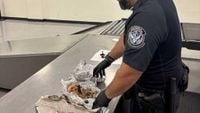Travelers passing through Tampa International Airport on September 18, 2025, likely expected the usual bustle of rolling suitcases and security checkpoints. But for U.S. Customs and Border Protection (CBP) officers, what began as a routine baggage inspection quickly spiraled into a case that’s left many Floridians—and the nation—reeling with questions.
According to Gray Local Media and confirmed by multiple outlets, CBP agents discovered a foil-wrapped duffel bag inside a passenger’s luggage containing what appeared to be human bones, including part of a skull. Along with these startling remains, officers also found prohibited plants and undeclared cigars. The passenger, whose identity and travel itinerary have not been disclosed, reportedly declared only ten cigars upon arrival, but this declaration turned out to be just the tip of the iceberg.
CBP Director of Field Operations Carlos C. Martel, who has overseen countless unusual finds at airports, commented on the unpredictable nature of international travel inspections. "At CBP, we never know what baggage may hold, but smugglers should know we’ll always have a bone to pick," Martel quipped in a post on X, the social media platform formerly known as Twitter. The lighthearted tone of his statement belied the gravity of the discovery and the serious health concerns it raised.
Images released by CBP, as reported by WWSB, show what looks like a skull and vertebrae partially wrapped in aluminum foil, meticulously laid out in evidence bags. Officers, donning gloves, can be seen inspecting the contents on an examination table. The stark photos have since circulated widely, fueling public curiosity and concern.
When questioned by officers, the traveler explained that the remains were intended for "ritual use." This admission, while unusual, is not entirely unprecedented. Throughout history, various cultures have incorporated human remains into spiritual or religious ceremonies. However, in the eyes of U.S. authorities, the health risks associated with transporting such materials far outweigh any claimed ritual significance.
CBP officials wasted no time in acting: the bones, along with the prohibited plants and undeclared cigars, were seized and destroyed. "Due to serious health risks, the items were seized and destroyed," Martel confirmed. The agency’s swift response was guided by a strict set of public health regulations designed to prevent the spread of pathogens and protect both airport staff and the broader public.
The Centers for Disease Control and Prevention (CDC) maintains rigorous guidelines for the importation of human remains into the United States. As outlined by USA Today, these rules require specific documentation, depending on the condition of the remains and the cause of death. For instance, a death certificate stating the cause of death is typically mandatory, along with official export and import clearances. When a U.S. citizen or lawful permanent resident dies abroad, the State Department steps in to assist families with paperwork and transportation logistics, ensuring all legal and health-related protocols are followed.
Federal law further stipulates that non-cremated remains must be shipped in leak-proof containers to minimize any risk of disease transmission. Even in cases where the deceased did not succumb to an infectious illness, the CDC warns that blood and bodily fluids may still pose a risk to handlers. Cremated remains, embalmed bodies, and clean, dry bones are generally allowed into the country without a permit. However, if the remains are of someone who died from an infectious disease and haven’t been cremated or embalmed, a CDC import permit is required before entry.
In this case, the traveler’s lack of proper documentation and the ambiguous condition of the bones prompted authorities to err on the side of caution. As Martel emphasized, “the case highlights the unpredictable nature of international travel inspections.”
While the traveler’s explanation of ritual use adds a layer of cultural complexity, CBP’s mandate is clear: public safety comes first. The agency did not reveal the passenger’s nationality or whether any criminal charges would be filed, and a Homeland Security spokesperson told WWSB that the investigation is ongoing. This leaves many wondering what, if any, legal consequences the traveler might face and whether the remains will ever be conclusively identified.
The incident has also reignited debate over the challenges faced by customs officials in an increasingly interconnected world. With millions of travelers and shipments crossing U.S. borders each year, the spectrum of prohibited or suspicious items is vast. From exotic plants and undeclared luxury goods to, in rare cases, human remains, CBP officers are tasked with making rapid, high-stakes decisions to safeguard the public.
For local Floridians, the story has become a talking point, with many expressing shock at the idea that such items could have slipped through the cracks if not for vigilant officers. As one airport worker, who asked to remain anonymous, put it, "You see all sorts of things come through, but this? I’ve never heard of anything like it."
Legal experts note that the transportation of human remains—regardless of intent—falls under a web of international, federal, and state regulations. The lack of transparency about the traveler’s background and the ultimate destination of the remains has only fueled speculation. Was this an isolated incident, or could it be part of a broader pattern of trafficking in ritual or ceremonial artifacts?
In the absence of more details, much remains unknown. However, the case serves as a stark reminder of the delicate balance customs officials must strike between cultural sensitivity and public health imperatives. As Martel’s wry comment suggests, the job is never dull—and sometimes, it’s downright macabre.
As the investigation continues, CBP and Homeland Security officials are urging travelers to familiarize themselves with the rules surrounding the importation of sensitive materials. The CDC’s guidelines are clear, but as this case demonstrates, enforcement often comes down to what officers find—and what travelers are willing to declare.
For now, the bones—and the story behind them—are in the custody of federal authorities. Whether the full truth will ever come to light remains to be seen, but one thing is certain: at Tampa International Airport, security officers will be keeping an even closer eye on what’s rolling through the baggage claim.





